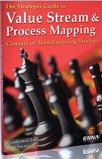|

The free newsletter of Lean Manufacturing Strategy
Lean Briefing Archives

Books & Videos

The Strategos Guide To Value Stream and Process Mapping goes far beyond symbols and arrows. In over 163 pages it tells the reader not only how to do it but what to do with it.
More info...
Strategos Guide to Value Stream & Process Mapping
Also...
Guide to Cycle Counting
Facilities & Workplace Design
Warehouse Planning Guide
Human Side of Lean Video


|
 |
Lean Manufacturing Leadership
Leadership Levels & Issues
|
Issues and Problems
For most organizations, problems prevent the direct,
linear achievement of a goal. The tasks for
accomplishment may be murky and solutions to problems
may be unclear. Moreover, the goal itself may be
unclear, unknown or controversial.
The problems faced by an organization may be adaptive
in nature. Adaptive problems
require changes in organizations structure, behavior,
values, culture or objectives.
Non-adaptive problems simply require the
application of existing approaches.
|
 Great Leaders- Mahatma Ghandi
The people who should be involved in problem-solving
varies. It depends on the problem and on the available
solutions.
Table 1 summarizes several types of problem-solution
complexes and the people that should be involved in
their resolution. These various problem-solution
combinations require different levels of leadership.
|
Table 1-- Organizational Issues
|
Problem/Issue Types |
Solutions Available |
People Involved |
|
Adaptive, Non-Technical & Unclear
|
Unknown and Unclear; Requires Evolution of Values and
Innovation
|
All Stakeholders
|
|
Non-Technical but Clear
|
Partly Known -Some Adaptive Learning Required
|
Experts Aid Diagnosis; Group Solves Problem
|
|
Technical & Clear
|
Technical, Solutions Exist
|
Expert-Leader Solves Problem
|
Levels of Leadership
Table 2 summarizes one perspective on leadership. It
views leadership at different levels: Transactional,
Relational, Transformational and Charismatic.
Clicking
on each the level below takes you to further discussion of
that leadership level.
If we map the leadership levels of table 2 to the issue
types of table 1, we see that lower levels of leadership
can cope with technical and non-adaptive problems.
Murky, adaptive issues require higher levels of
leadership.
|
Different writers and researchers attach
different
meaning to these terms. For example, some writers view
charismatic leaders as any leader possessing charisma.
Others view charismatic leaders as transformational
leaders with the added characteristic of charisma.
When
viewing these pages and the other literature, you must
infer from the context whether the discussion is about
the pure Charismatic or Transformational- Charismatic
Leader.
|
Table 2-- Levels of Leadership
|
|
Level
|
Activities & Competencies
|
Personal Characteristics
|
|
IV
|
Charismatic- Transformational
(Click for
More ..)
|
-
All of
Level III +...
-
Personal
Charisma
|
|
|
III
|
Transformational
(Click for
More ..)
|
-
All of
Level II +...
-
Frames
Holistic Issues
-
Sets New
Goals & Direction
-
Creates
Meaning
-
Manages
Creative Conflict
-
Promotes
Organizational Learning
-
Creates A
Context for Dialogue
-
Manages
Paradigms
-
Creates
Commitment Through Shared Values
|
-
Assertive
-
Seizes
Opportunities
-
Tolerates
Risk
-
Uses
Systems Thinking
|
|
II
|
Relational
(Click for
More ..)
|
|
|
|
I
|
Transactional
(Click for
More ..)
|
-
Accepts
Organizational Goals
-
Uses
Extrinsic Motivators
-
Works
Within Existing System
-
Takes
Action
|
-
Directive
-
Dominating
-
Action-Oriented
|

|





